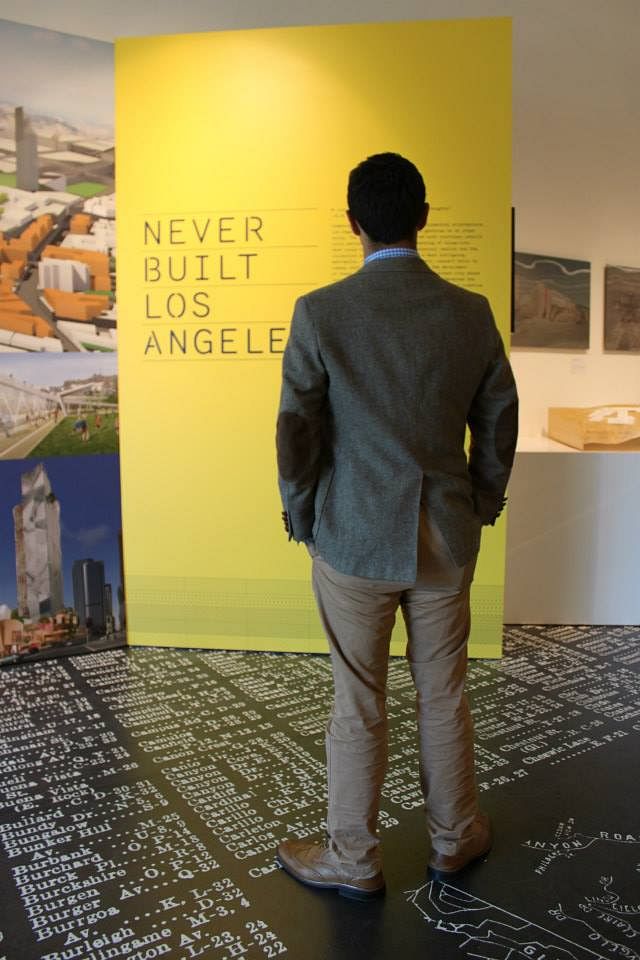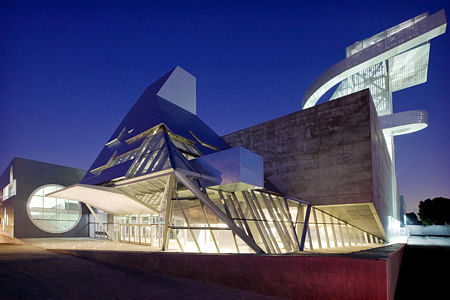

Does L.A. even want to be defined by a provincial architecture? Is it necessarily a disadvantage that the city serves as an incubator, rather than a fairground, for architectural innovation -- or as Thom Mayne put it, as a world-class global exporter of urban and architectural ideas? It may be that the very landscape of inspiration is an obstruction to execution.
“Never Built: Los Angeles”, on view at the A+D Museum in L.A. until October 13, bills itself on fantasy -- the projects on display never came to be, prompting the viewer to imagine a different Los Angeles for each unbuilt structure. But the exhibition, curated by Sam Lubell and Greg Goldin, while operating as a collection of science fictions, doesn’t really editorialize on what should (or should not) have been built. “Never Built” then operates as a diving board from fantasy into the frothy waters of Los Angeles’ current urban environment, turning attention towards 21st century possibilities of identity and innovation. This past Thursday, at a panel discussion moderated by Lubell (also the West Coast Editor at The Architect’s Newspaper) on A+D’s backyard patio, the exhibition unfolded into that very network of conjectures -- some drastic or cynical, others constructive and optimistic. Despite the chilly weather, the gathering of urban and architectural professionals interacted warmly and enthusiastically, responding to Lubell’s questions with no small share of personal experience along with professional opinion.

Fit for a city council meeting, the panelists represented a variety of seasoned civic professionals, from architecture, urban planning and educational communities: Gail Goldberg, the Executive Director of Urban Land Institute Los Angeles, Thom Mayne, principal architect at Morphosis, Mott Smith, principal at the strategic planning and development firm, Civic Enterprise Associates, and Michael Woo, the Dean of the College of Environmental Design at California State Polytechnic University, Pomona. If that heftily qualified list of panelists is any indication, the focus here is on expanding the conversation of LA’s urban identity outwards, away from an academic discussion amongst designers and urban theorists. In this city of open space, there lies a wide gap between potential and realization -- a city full of architectural innovators, whose large-scale projects largely appear elsewhere.
Individuals need challenging architecture (whatever that means) to develop into constructive members of urban society. Their discussion alluded to fractured and disinterested, or apathetic, city governments, that lacked the chutzpah and motivation to invest in grand, longer-term architectural gestures. But the dissatisfaction isn’t motivated by a single alternative here -- does LA even want to be defined by a provincial architecture? Is it necessarily a disadvantage that the city serves as an incubator, rather than a fairground, for architectural innovation -- or as Thom Mayne put it, as a world-class global exporter of urban and architectural ideas? It may be that the very landscape of inspiration is an obstruction to execution. There’s simply too many varied communities, lacking a common focus or the incentive to create one, to allow for planning on the large- and long-term scale. Gail Goldberg empathetically summarized the planning style of Los Angeles as “transactional” -- as simply trying to get by with minimal damage and meet immediate needs, rather than plan for any type of coherent future. Mott Smith, representing the developer’s viewpoint in the panel, hooked onto the harsher implications of Goldberg’s frustration: that transactional design is debilitatingly concerned with minimizing potential conflict, rather than maximizing quality of life, which can actually stunt the civilian’s personal development (referring to the ideas of sociologist Richard Sennett). That is, individuals need challenging architecture (whatever that means) to develop into constructive members of urban society. Whether the folks who actually use the architecture agree with this motivation is another issue, and one that further separates the modernist design ethos of benevolent dictatorship, and the perpetual compromises of democratically-driven populism.

“Generational mortality”, a term coined by Motts during the panel discussion, sums up the cynical (although apt) analysis of what L.A. needs to change its culture of transactional design timidity. But aside from waiting for the more conservative generations to simply die out, what strategies can Los Angeles implement to endear its citizens to innovative architectural and urban design? Exposure is certainly an issue: while initiatives such as the Getty’s “Pacific Standard Time Presents: Modern Architecture in L.A.” have brought architectural discourse closer to the public surface, and “Never Built” (which is not affiliated with “Pacific Standard Time”) makes front-page news at the Los Angeles Times, publicity is not enough -- citizens, at the earliest level, need to have access to educational resources that exposes the potential of architecture and urban design to determine quality of life. This isn’t to suggest that everyone should become an urban acupuncturist, but that civic duty should extend beyond law and politics and into art and design. Just like forcing students to take “home economics” and shop class, schools should begin to assume that architecture and urban environments will be an irrevocable part of their students’ adult lives.
A laudable attempt at the aforementioned priorities is Coop Himmelb(l)au’s Central Los Angeles Area High School #9 for the Visual and Performing Arts. While not an unequivocal success, the structure undeniably combines the power of provocative design with educational function, and therefore at least succeeds as a performative gesture. With so many competing interests within Los Angeles, whether reactionary location managers, cash-pressed politicians or fantastically rich philanthropists, it’s absurd to think a city-wide consensus on conflict-free designs can even hypothetically exist. That remains true within the architectural community -- architects are not a single-minded organism, and have different versions of what constitutes innovative, constructive design solutions.

The immediate goal is then to push urban design and architecture into daily conversations -- through political dialogues, media representation, and most importantly, educational institutions (the younger the students, the better). Generational mortality is a simple inevitability, and won’t ensure anything, but at the very least, increased exposure will help identify and emphasize the potential of art in society.
Former Managing Editor and Podcast Co-Producer for Archinect. I write, go to the movies, walk around and listen to the radio. My interests revolve around cognitive urban theory, psycholinguistics and food.Currently freelancing. Be in touch through longhyphen@gmail.com
No Comments
Block this user
Are you sure you want to block this user and hide all related comments throughout the site?
Archinect
This is your first comment on Archinect. Your comment will be visible once approved.